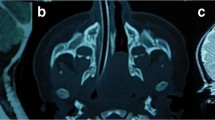Abstract
The objective of the study is to evaluate the surgical outcome between free nasoseptal mucoperichondrial flap using septal cartilage vs fascia lata using fat in terms of morbidity, hospital stay and postoperative complications. It is a retrospective comparitive study of 127 patients, diagnosed with CSF leak and who underwent repair of anterior skull base defect using free nasoseptal mucoperichondrial graft with septal cartilage in 73 cases compared with fascia lata with fat in 54 cases over the time frame of 5 years. The success rate with free nasoseptal flap with septal cartilage was 97.3% and that with fascia lata with fat was 96.3%. There was a significant association between mean hospital stay and the technique of CSF repair (unpaired t test, p −0.02). In our study the complications following the repair with free nasoseptal flap with septal cartilage was significantly less (p < 0.05, chi square test). The above study concludes that in patients treated with free nasoseptal flap using septal cartilage has less hospital stay, less post-operative morbidity in the form of pain, movement and dependence for cleaning and dressing in comparison to fascia lata using fat.


Similar content being viewed by others
References
Cairns H (1937) Injuries of the frontal and ethamoidal sinus withspecial reference to cerebrospinal fluid rhinorrhea aand aerocele. J Laryngol Otol 52:589–623
Dohlman G (1948) Spontaneus cerebrospinal fluid rhinorrhea. Case report by rhinologic methods. Acta Otolaryngol (Stockh) 67 [suppl]:20–23.
Prickett KK, Wise SK, DelGaudio JM (2011) Choice of graft material and postoperative healing in endoscopic repair of cerebrospinal fluid leak. Arch Otolaryngol Head Neck Surg 137(5):457–461
Dodson EE, Gross CW, Swerdloff JL, Gustafson LM (1994) Transnasal endoscopic repair of cerebrospinal fluid rhinorrhea and skull base defects: a review of twenty-nine cases. Otolaryngol Head Neck Surg 111:600–606
Marks SC (1998) Middle turbinate graft for repair of cerebral spinal fluid leaks. Am J Rhinol 12(6):417–420
Presutti L, Mattioli F, Villari D, Marchioni D, Alicandri-Ciufelli M (2009) Transnasal endoscopic treatment of cerebrospinal fluid leak: 17 years’ experience. ACTA Otorhinolaryngol Italica 29(4):191
Costantino PD, Hiltzik DH, Sen C, Friedman CD, Kveton JF, Snyderman CF, Gnoy AR (2001) Sphenoethmoid cerebrospinal fluid leak repair with hydroxyapatite cement. Arch Otolaryngol Head Neck Surg 127(5):588. https://doi.org/10.1001/archotol.127.5.588
Eloy JA, Kuperan AB, Choudhry OJ, Harirchian S, Liu JK (2012) Efficacy of the pedicled nasoseptal flap without cerebrospinal fluid (CSF) diversion for repair of skull base defects: incidence of postoperative CSF leaks. Int Forum Allergy Rhinol, vol 2, No. 5, pp 397–401. Hoboken: Wiley Subscription Services, Inc., A Wiley Company.
Bernal-Sprekelsen M, Alobid I, Mullol J, Trobat F, Tomás-Barberán M (2005) Closure of cerebrospinal fluid leaks prevents ascending bacterial meningitis. Rhinology 43(4):277
Patel K, Gugliani A, Rajesh Vishwakarma (2019) Endoscopic cerebrospinal fluid leak repair: how we do it. Int J Otorhinolaryngol Head Neck Surg 5(4):965–968
Banks CA, Palmer JN, Chiu AG, O’Malley BW Jr, Woodworth BA, Kennedy DW (2009) Endoscopic closure of CSF rhinorrhea: 193 cases over 21 years. Otolaryngol Head Neck Surg 140(6):826–833
Lee TJ, Huang CC, Chuang CC, Huang SF (2004) Transnasal endoscopic repair of cerebrospinal fluid rhinorrhea and skull base defect: ten-year experience. Laryngoscope 114(8):1475–1481
Hosemann WG, Weber RK, Keerl RE, Lund VJ (2000) minimally invasive endonasal sinus surgery. Thieme, Stuttgart New York pp 76–79.
Hegazy HM, Carrau RL, Snyderman CH, Kassam A, Zweig J (2000) Transnasal endoscopic repair of cerebrospinal fluid rhinorrhea:a meta-analysis. Laryngoscope 110:11661172
Wigand ME (1981) Transnasal ethmoidectomy under endoscopical control. Rhinology 19(1):7–15
Kashkouli MB (2007) A novel technique of small incision fascia lata harvestingwithout a faciatome for frontalis suspension procedure. Orbit 26:203–206. https://doi.org/10.1080/01676830701376122.
Bleyen I, Hardy I, Codere F (2009) Muscle prolapse after harvesting autogenousfascia lata used for frontalis suspension in children. Ophthal Plast Reconstr Surg 25(5):359–360
Wheatcroft SM, Vardy SJ, Tyers AG (1997) Complications of fascia lata harvestingfor ptosis surgery. Br J Ophthalmol 81:581–583
Marks SC (1998) Middle turbinate graft for repair of cerebral spinal fluid leaks. Am J Rhinol 12(6):417–420
Vitali M, Canevari FR, Cattalani A, Grasso V, Somma T, Barbanera A (2016) Direct fascia lata reconstruction to reduce donor site morbidity in endoscopic endonasal extended surgery: a pilot study. Clin Neurol Neurosurg 1(144):59–63
Yadav YR, Parihar V, Janakiram N, Pande S, Bajaj J, Namdev H (2016) Endoscopic management of cerebrospinal fluid rhinorrhea. Asian J Neurosurg 11(3):183
Funding
None.
Author information
Authors and Affiliations
Corresponding author
Ethics declarations
Conflict of interest
The authors declare that they have no conflict of interest.
Ethical Approval
All procedure performed in this study involving human participants were in accordance with ethical standard.
Additional information
Publisher's Note
Springer Nature remains neutral with regard to jurisdictional claims in published maps and institutional affiliations.
Rights and permissions
About this article
Cite this article
Chavan, S.S., Potdukhe, K.V., Kale, V. et al. A Comparitive Study of Endoscopic Skull Base Reconstruction in CSF rhinorrea using Nasoseptal Flap with Septal Cartilage v/s Fascia Lata With Fat. Indian J Otolaryngol Head Neck Surg 73, 233–239 (2021). https://doi.org/10.1007/s12070-021-02379-1
Received:
Accepted:
Published:
Issue Date:
DOI: https://doi.org/10.1007/s12070-021-02379-1




